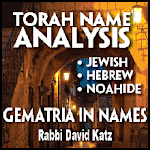Parashas Behar
Onkelos
the Man and the Commentary
Rabbi David Katz
The
Torah that we know today, as it comes in most standard editions, contains the
super-commentary written by Onkelos; it is generally recognized as the gold
standard for understanding the true understanding of the Torah. Of course this
means that for all of time so far, scholars have struggled with his words to
fully grasp their meaning end extensive depth. When we focus on Onkelos in
Behar, we find a little nugget of truth that may be an actual thread to
understanding him light years beyond where most are holding of those who tread
his waters. This is none other than his unique wording with the various "Ger"
references in the Parasha; he sets a new precedent in that where there was Ger
Code before through the various Talmudic Sages, he takes it to a new level.
Lastly, he was a Ger himself, and now it only seems fitting for this code to go
full circle, and end up in the best hands that it ever could; it is said that
Onkelos is the official translation of the Torah –Moses –Authoritative.
Praiseworthy are the Gerim that they shall live forever, as they are as eternal
as the very words of Torah that they are invested in – side by side with
Israel.
The
word Ger exists in the Torah approximately one hundred times, and the generic
translation in English is often inaccurately "convert" while its
actual translation is subject of much investigation! In truth each mention of
Ger is explained to be a world by itself and it is properly understood through
the entire context of each full location; each location is different perforce.
The logical outcome of such a framework in Torah is that by learning the entirety
of all that is related to the Ger, one will quickly identify a rudimentary code
within the text. Many of the "code words" [like, "the Ger of the
gate"] are words that often turn up for context, and become systematic due
to their regular appearance in text. Thus the World of the Ger becomes
illuminated with experience and repetition, even fostering a model for other
subtopics contained within the Torah.
There
is great light and principles in learning that stem from the Ger code, and
these revelations formulate the basic structure of "learning about the
Ger." One simple yet potent realization is that as one quickly learns from
context, there are many types of Ger. One could be anywhere from a convert,
Noahide, Ger Toshav, dweller/stranger, etc. People then get lost and assume
that the verse must speak only of one, and then come to exclude the rest;
moreover, most will erroneously assume the convert is the most practical and
logical of them, due to recent history in face of unprecedented ancient history
that sings an entirely different tune! This idea that we can have more than one
concept lumped together is called "ribui" [inclusive] as opposed to
"miyut" [exclusive]. The Torah is here to contain light, not minimize
it.
The
Talmudic scholars took this methodology of code, and formulated it into a sure
proof wisdom of how to identify the Ger, and even using this as an effective
way to learn matters in Torah through a type of code. [There are many
principles of learning Torah through tradition, as a way to learn text in
unconventional ways; a set of thirteen of them are brought down in the morning
prayers identified as Rabbi Yishmael's 13 ways of learning] Out of their
schools came the code, and from there we have terms like Ger Tzedek which have
a specific rabbinic meaning [as it isn't actually a Torah term, but rather an
Oral Torah term to help rabbis classify the Written Torah's Ger with
identifiable context.] to help understand with more clarity. In the end, the
World of Ger is born, and we can say goodbye to the generic convert exclusive
connotation, and allow our eyes to open and view just how featured the Ger is
in Torah and the World.
And
this is where we thought the story ended…a Ger code and precedent of many types
of Gerim. Only one question could possibly remain, as one could wonder where
the Rabbis learned the Ger code, or if there was a precedent in something that
predates the Talmudic era with a prototype predecessor. The answer is yes,
there was – and it was Onkelos.
Onkelos
merited scribing the Torah's authentic Aramaic translation; he was a Ger, and
as it turns out, he coded the code into his commentary/translation of the Written
Torah. Where he differed from the
Rabbis, was that he was simply earlier and the concept innovator – he laid down
principles that would eternally serve the advanced scholar, once he
"graduated" through the later generations layers over his work. It
would seem that to even understand and recognize his penmanship, we would have
to learn the latter writings and digest them first very thoroughly. With full
proficiency and fluency the interested scholar can advance through gaining a
grasp of the subtle distinctions left out of the basic Ger Universe, and all
the more so locked out of the generic place of simply referring to the convert
as the lock on all doors of perception.
Onkelos
effectively gives us the true blueprint, which would look like a totally new and
advanced code that could accomplish far greater implications of understanding.
One of his biggest principles is the idea of simply defining "what is a
Ger" once and for all. His definition is nothing short of amazing, for he
describes it like this: [explained] there are many types of Gerim, and each
will have two stages – the process and transition of becoming [whatever that
new thing is] and the actual stage where he settles [on whatever it is he is
now]. Whether he became a convert, of dweller, or Noahide, or whatever – each one
will have come to a new place from a different place. Thus he will have picked
up and traveled – process and settled into a new distinction – and settled
identity. This is called Giura in Aramaic, and this term is one term that can
be used for all types of Gerim together – ribui, not miyut.
With
this revelation we can plug in the old Ger code tactics of using the rest of
the verse to explain the details of the Ger(im) of each verse, and through
Onkelos, we can actually see his code. Our Parasha has a most profound Ger in
it under these conditions, in that he is a Ger Toshav as mandated by the basic
Hebrew. Where Onkelos takes it another step is that he refers to him as "uncircumcised"
– this is fantastic because he has told us inherent code from the verse in a
whole new lens to see new code – different than our previous model. Thus by
following this path, we will see that Onkelos is telling us that the path is
already paved, and when we walk down his path, we are walking the authentic Ger
code path. Each listing of Ger in Torah under Onkelos' pen is a perfectly
manicured garden of delight, not leaving any stone unturned; we now know every
type of Ger and element in Torah, and different from before, for now it is much
more precise, clean, and comes with less guesswork. Effectively, a new code has
been established, and as before, we are not looking at an overabundance of
convert slant.
Parashas
Behar graces us with perhaps some of Torah's most profound Ger referencing in
all of Torah. We can always delve deeper into Ger code from the authorities of
old; but if we go ancient and into Onkelos, we can see the true beauty of God's
Torah, through its infinite layers of understanding. One thing remains clearer
than ever from Onkelos' code – and that is the Ger is certainly cemented into
the Torah, and in most profound ways. As much as Onkelos is eternal – he and
his work, it is more than obvious so too is the Ger – for he is in the very
fabric of the Torah's DNA; it is tragic when people wish to freely convert away
potential Gerim for simply not having the merit to fall in love with the Ger on
deeper levels. Yet one thing remains constant, and Onkelos will forever give
testimony to this one fact – God loves the Ger, and the Ger can only Live. Of
one face of Torah among its many others, making Gerim is what it is about, and
a true Blessing it is to be involved with God's most holy work and a miyut this
is not, for the Ger's very definition is our now famous ribui – as he comes to
include all, as the Fourth House of Israel.





 Posted in:
Posted in: 




0 comments :
Post a Comment
Note: Only a member of this blog may post a comment.